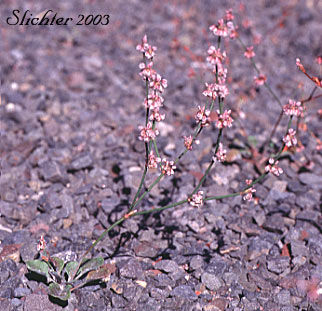

 The
photo at right shows Bailey's buckwheat as seen on a pass to the northeast
of Lakeview, OR on OR Highway 140.............early September, 1997. Note
the single involucre with its cluster of flowers at the nodes for each branch
as well as at the branch tips.
The
photo at right shows Bailey's buckwheat as seen on a pass to the northeast
of Lakeview, OR on OR Highway 140.............early September, 1997. Note
the single involucre with its cluster of flowers at the nodes for each branch
as well as at the branch tips.
Broom buckwheat is an annual, upright, non-mat forming buckwheat to 40 cm tall. The erect stem arises from a cluster of basal leaves which are ovate to broadly elliptical in shape. They are mostly gray-tomentose below, less tomentose to green above and measure 5-30 mm long with entire margins. The leaf petioles are 1-3 times longer than the blades.
The flower stem is cymose, or widely branched two to three times, with minute white, yellow, or pink clusters of flowers scattered the length of the branched stems. The flower stems may start out tomentose hairy, and typically end up a smooth green at the tops of the stems. A single involucre is found at the node for each branch, or at the branch tips. The involucre is bell-shaped, 1.5-2 mm long and not heavily ribbed. The lobes of the involucre are rounded and about 1/3 as long as the tube. The perianth is about 1.5 mm long with the lobes ovate-lanceolate in shape. The stamens are about three-fourths the length of the perianth.
Eriogonum vimineum: Perianth 2.5-3 mm long, the lobes of the perianth oval to obovate in shape. Involucres cylindric to narrowly cylindric-conical, 2-3 mm long and strongly ribbed.
Sandy or rocky soil from desert to sagebrush or pine forests.
A widespread species, Bailey's Buckwheat is found from Central Washington, southward along the east side of the Cascades into Mexico, eastwards towards the western edge of the Rocky Mts.
